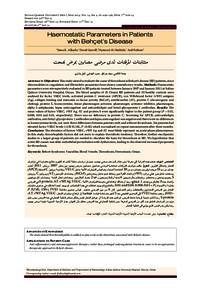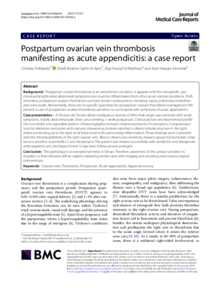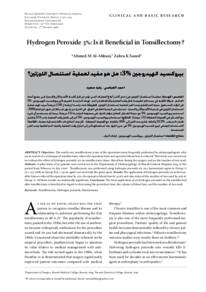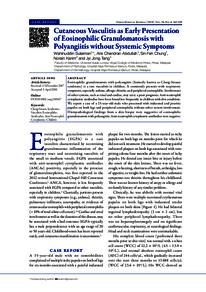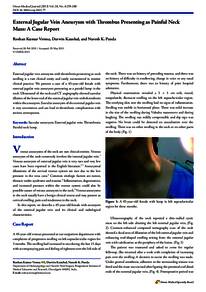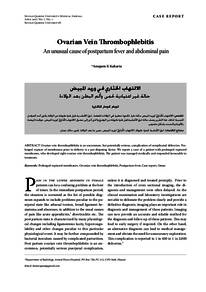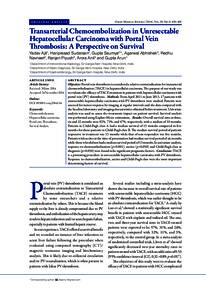وثيقة
Haemostatic parameters in patients with Behçet's disease.
المساهمون
الناشر
College of Medicine, Sultan Qaboos University.
ميلادي
2014-05
اللغة
الأنجليزية
الملخص الإنجليزي
This study aimed to evaluate the cause of thrombosis in Behçet's disease (BD) patients, since
abnormalities in coagulation and fibrinolytic parameters have shown contradictory results. Methods: Haemostatic
parameters were retrospectively evaluated in BD patients treated between January 2007 and January 2011 at Sultan
Qaboos University Hospital, Oman. The blood samples of 35 Omani BD patients and 30 healthy controls were
analysed for factor VIII:C levels, activated protein C resistance (APCR), von Willebrand factor (vWF) antigens
(Ag), collagen binding and ristocetin co-factor activity (RiCoF), antithrombin (AT), protein C (chromogenic and
clotting), protein S, homocysteine, tissue plasminogen activator, plasminogen activator inhibitor, plasminogen,
alpha 2-antiplasmin, lupus anticoagulant and anticardiolipin and beta2-glycoprotein-1 antibodies. Results: The
mean values of factor VIII:C, vWF Ag, AT and protein S were significantly higher in the patient group (P = 0.01,
0.006, 0.04 and 0.01, respectively). There was no deficiency in protein C. Screening for APCR, anticardiolipin
antibodies, anti-beta2-glycoprotein-1 antibodies and lupus anticoagulant was negative and there were no differences
in homocysteine levels, nor were there differences between patients with and without thrombosis. Six patients had
elevated factor VIII:C levels (>150 IU/dL, P <0.02) which normalised on repeat measurements after three months.
Conclusion: The elevation of factors VIII:C, vWF Ag and AT most likely represent an acute phase phenomenon.
In this study, thrombophilic factors did not seem to explain thrombotic tendency. Therefore, further mechanistic
studies in a larger group of patients are needed to elucidate the basis for thrombosis in BD. We hypothesise that
active BD causes vasculitic endothelial perturbation with dysfunction, leading to the observed increased propensity
for thrombosis.
برعاية
Sultan Qaboos University.
المجموعة
URL المصدر
الملخص العربي
الهدف: هدفت هذه الدراسة إلى معرفة سبب خثار الدم عند مرضى بهجت، حيث إن دراسات سابقة كانت قد أظهرت نتائج متضاربة في مؤشرات التخثر وانْحِلاَلُ الفِبْرين. الطرق: حللت مؤشرات المُرْقئات استعاديا لمرضى عمانيين مصابين بمرض بهجت بين يناير 2007 ويناير 2011. وأخذت عينات من دم 35 مريضا وقورنت بعينات دم من 30 أَشخاصا أصحاء وتم قياس المؤشرات الآتية: عامل VIII:C ومقاومة بروتين C المنشط (APCR) ومستضد عامل فون فيلي برانرد (vWF) واتحاد الكولاجين ونشاط تميم عامل ريستوستين (RiCoF) ومضادات الثرمبين (ِAT) وبروتين C وبروتين S وهوموسيستين ومنشطات ومثبطات بلازمنوجين الأنسجة والبلازمونجين والفا 2 مضاد البلازمين ومضادات تخثر الذئبة ومضادات كارديوليبين وأضداد بيتا 2 غلايكو بروتينات1. النتائج: وجد أن هنالك ارتفاعا في متوسط المؤشرات الآتية:، VIII:C، vWFAg، AT، S protein في المرضى مقارنة بالأصحاء ( بالتتابع0.01 and 0.04, 0.006 ,0.01 =P) لم يوجد اختلاف في بقية المتثبتات. لم يوجد أيضا اختلاف في مستوى متثبتات التخثر بين المرضى المصابين بالتجلطات وغير المصابين. كان 6 من بين المرضى عندهم قياس مستوى متثابتة FVIII (<0.02>P, IU/dL 150) .رجعت متثابتة FVIII إلى المستوى الطبيعي بعد 3 أشهر بعد إعادة قياسه. الخلاصة: إن ارتفاع مؤشرات التخثر، S protein, AT, vWFAg, VIII:C ربما كانت نتيجة لزيادة نشاط المرض. لم تثبت هذه الدراسة أن عوامل التخثر تفسر بشكل مباشر قابلية التخثر في هذا المرض. يجب عمل مزيد من الدراسات لتشمل عدد أكبر من المرضى لمعرفة سبب قابلية التخثر في هذا المرض. نعتقد بأن التهاب جدار الأوعية الدموية نتيجة مرض بهجت ربما يكون هو السبب الذي يؤدي الى قابلية التخثر.
قالب العنصر
مقالات الدوريات

